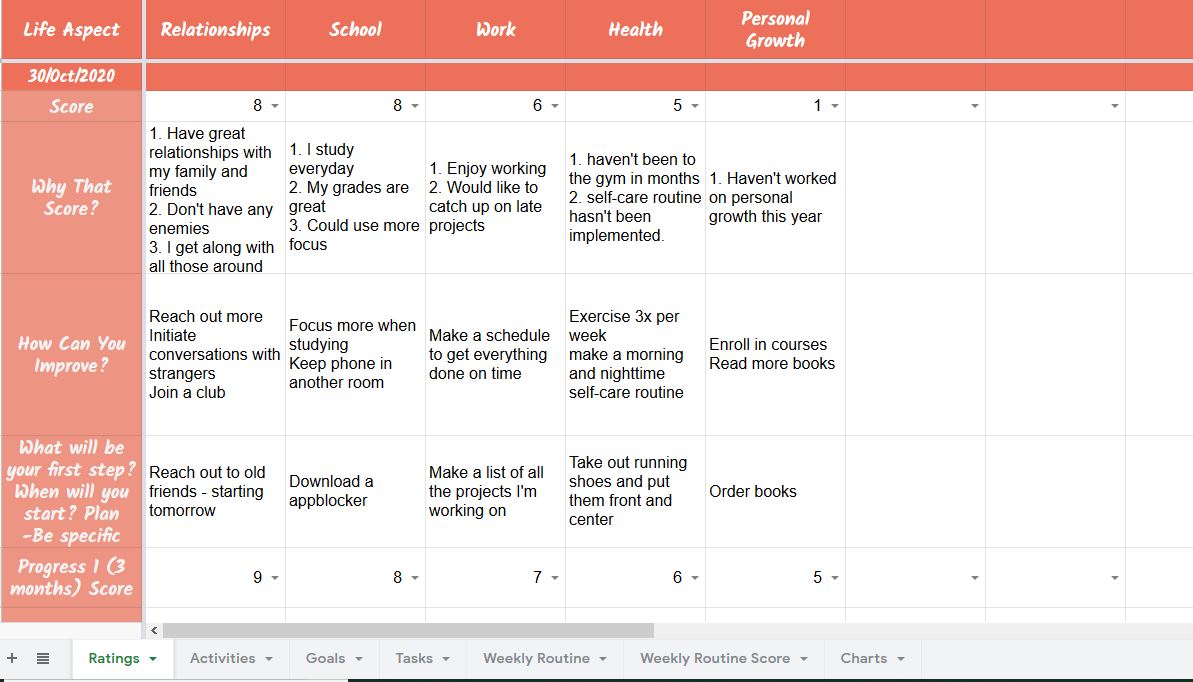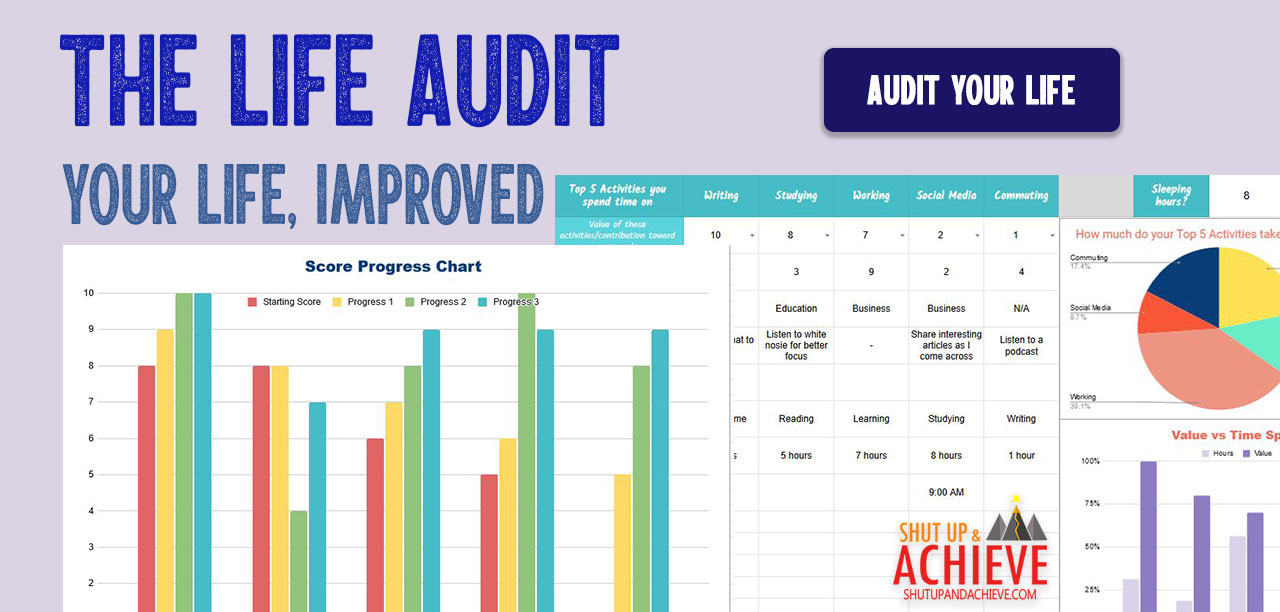Take Action
How to Do a Life Audit: A Shockingly Simple Strategy
You can only move through life in one direction: forward.
You can also stay put, having been glued in place by an unfortunate event you keep reliving. But nobody wants to do that.
So, we move in the one direction we can. We keep moving forward.
You might think, “Of course, that’s exactly what we should do in life!”
Not exactly.
There are two ways you can move forward. You can actively move forward with a goal in mind. This is the good way to move forward.
Or you can move forward because you have nowhere else to go. You’re not accomplishing anything as you move forward. You’re not improving. Time pushes you forward, so forward is the way you go.
Do you know how you are moving forward?
In both cases, time passes, and you move ahead, so they feel the same. How do you tell if you’re moving forward the right or wrong way?
Here’s the secret:
You look back.
You have been living life for a long time by now. Seriously, it’s been years. By now, you should have some data on how you are moving forward. If not, it’s because you never took the time to look.
[easy-tweet tweet=”“Sometimes, you have to look back in order to understand the things that lie ahead.” ― Yvonne Woon” user=”shutupachieve” url=”https://shutupandachieve.com/assess-your-life” template=”qlite”]You’ve been so busy trying to reach the next stop—achieve the next goal—that you never stopped to think if you are living the way you want to.
Tell me:
If I ask you right now, how is your life going, will you know the answer?
The truthful, deep answer, not the “Oh, everything’s fine” answer you give your colleagues at work.
If you don’t look back, how will you ever know if what you are doing is working? If you don’t look at the results of your labor, will you know that you did it right?
It’s like taking a test assuming you did well, but never getting your grade back. You think you answered everything right, but you have no way of knowing for sure.
What’s more is that, if you don’t know your grade, you won’t know what you need to improve on. You’ll keep making the same mistakes over and over again.
So you know you need to reflect on your life, but how do you do that?
It all starts with looking at where you are in life now. After all, the sum of your previous habits, choices, and actions are what got you here.
A few things you need to know:
- What are you doing with your life?
- What are your priorities?
- What are your goals?
- What activities do you spend time on?
- What activities would you rather spend your time on?
We all have superficial answers to these questions, but that’s not what we’re going for here. Dig deep to truly understand where you stand in life and what you need to change.
Reflecting on your life is like conducting an audit on your life.
So, let’s get started auditing your life.
How To Conduct a Life Audit
A life audit is a way to assess your life. Who you are and what you do are too diverse to be summed up into the word “life”
1) Determine Your Life Aspects
To assess your life, you first must figure out what your life is made of. Life is divided into categories: your work life, your personal life, your family life, your social life and so on. The aspects that make up your life are unique to you.
What aspects are your life made of? What do you spend time on? What would you like to spend time on?
Brainstorm Your Life Aspects
Write a list of all the activities you do, would like to do, and your goals and values. Then, divide them into categories.
Your categories can be as specific as broad as you like. For instance, one of your life aspects may be Work or you could break it down into ‘work projects’, ‘work ethic’, and so on.
Here are some examples of life aspects:
- Career
- Finance
- Family
- Social Life
- Health
- Personal Growth
- Spiritual
- Fun/Recreation
- Community
- Education
- Fitness
Looking for a simple way to audit your life? Check out the Life Audit Workbook.
2) Analyze Your Life Aspects
You’ve divided your life into categories. Now ask yourself, how am I doing in each of them?
Here’s an example:
One of my aspects is personal growth. To me, personal growth represents expanding my horizons, living new experiences, and learning new things. I contemplated how many books I read and how many times I stepped out of my comfort zone.

I discovered that I was barely doing anything that contributed to my personal growth. I would read some blog posts here and there. I would also read a few books a year, but that was it!
Ruminating over this aspect showed me that I could do better.
Rate Your Life Aspects
Consider what you are currently doing in each life aspect. Are you satisfied with your efforts or would you like to do more? Give yourself a score from 1 to 10 in each aspect and then write a short summary of why you gave yourself that score.
3) Set Your Destination
“If you don’t know where you want to go, then it doesn’t matter which path you take.” ― Lewis Carroll
Each life aspect now has a score, so you have your starting point. Now, think about what score you would like that aspect to have.
Ideally, you’d want all of your life aspects to be a ten. Yet, it’s important to be realistic.
My personal growth score was a 2. I knew I could do better, and I wanted to do better. After reviewing my schedule, I realized there was no way I could maximize my personal growth without sacrificing higher-priority life aspects. I concluded that I would be satisfied with a score of 6 in this life aspect.
Giving your life aspects a goal score isn’t enough, though. You also need a plan to reach that score.
One method I find helpful is to plan in reverse. Visualize what your life would look like after you’ve reached your goal. Be specific. What do you days look like? Then, establish what needs to be done to make that fantasy a reality.
Determine Your Goal
For each of your life aspects, consider what score you would like to reach in the upcoming months. Be realistic. Not all of your life aspects will reach ten. Decide on a score you’d be satisfied with.
Then, write down ways to attain that score. What tasks do you need to do? What resources will you need? Include these into your schedule to ensure you actually get to them.
(Need a way to track the new habits you’ll be building? Check out the Habit Tracker 2.0)
4) Do, Observe, and Refine
Understanding where you are in life changes your perspective on activities you do. You become more mindful of how your actions affect you long term. As you become more aware, you’ll find new ways to enrich your life aspects.
With your new insights, come back to your life aspect every now and then, and tweak your plan. Document how you’ve improved and decide what you can do from there.
Revisit Your Life Audit
Writing down your activities and priorities will bring your attention to them in your daily life. Focus on what you’re doing and how you can do better. 3 months after you conducted your life audit, revisit it and document your progress. Add that date to your schedule now, so you don’t forget to review it in 3 months. Update your life aspect score, and devise new ways to grow even further.
A Simple Way to Conduct Your Life Audit and Assess Your Life
A lot of thought goes into assessing your life. I want to make it as easy as possible for you. That’s why I made The Life Audit Powerbook. It’s a premade Google Sheets or Excel spreadsheet ready for you to fill in with your life aspects, scores, and plans. It even has plenty of colorful charts so you can see your progress and goals at a glance.
In the Ratings sheet, you rate each of your life aspects, reflect on your score, and plan to improve. It even includes 4 progress scores, so you can revisit your life audit each 3 months to rate and reflect on your growth.
In the Activities sheet, you can analyze your top 5 activities and how they contribute to your goals. Then, you can move on to the Goals sheet where you determine your goals and formulate a strategy to accomplish them.
The Life Audit Workbook even has a weekly routine sheet. How many times have you said you’d do something but never got to it?
That’s why you need this workbook.
You get to build your ideal weekly routine. Your weekly routine will be compared to your goals, tasks, and priorities, and you’ll receive a Weekly Routine Score. The higher your score, the more likely your schedule will lead you to success.
Audit Your Life Today!

